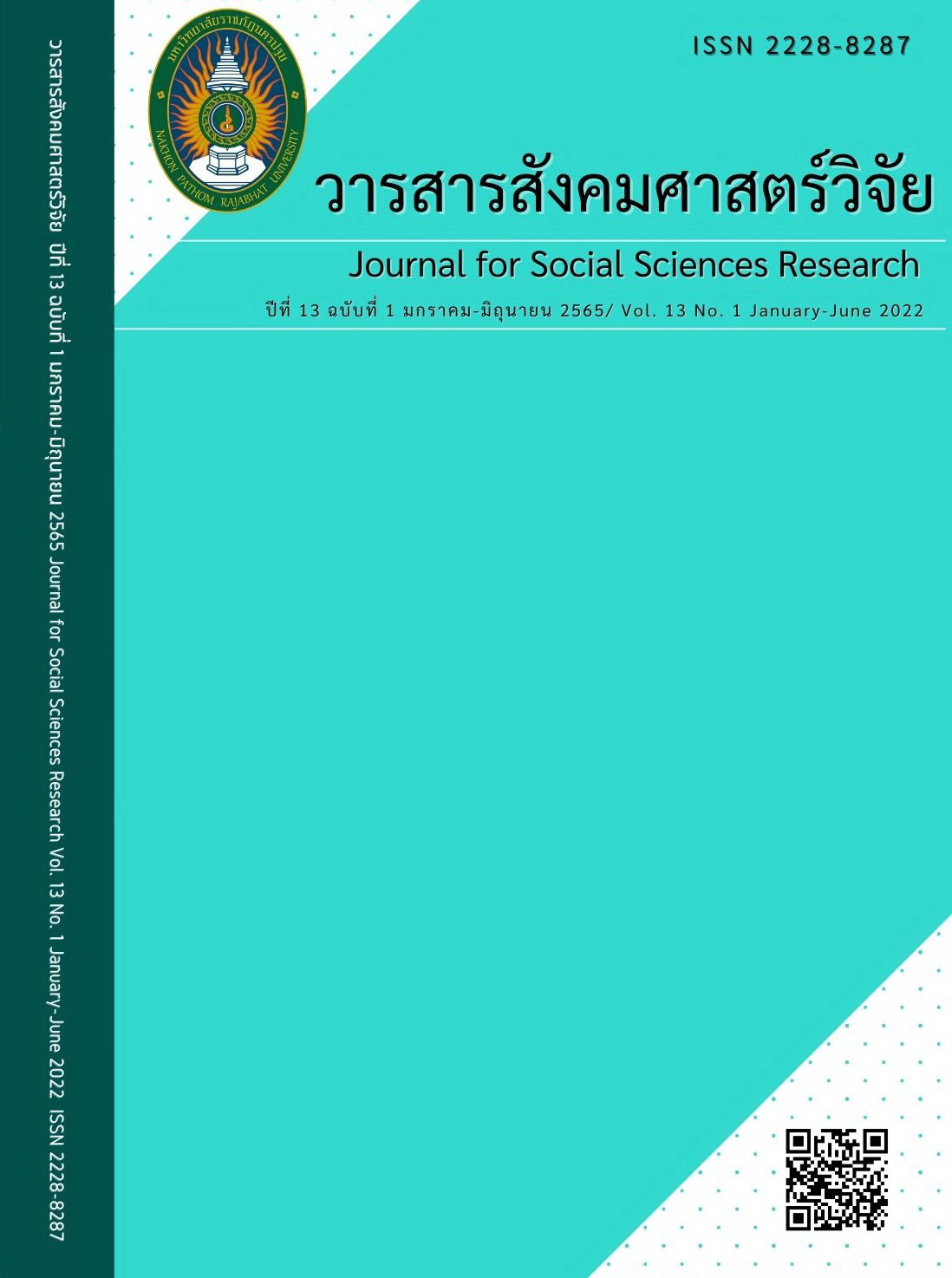THE STUDY OF EMOTIONAL INTELLIGENCE OF SUBSTANCE ABUSE STUDENTS IN SAMUT PRAKAN PROVINCE
Main Article Content
Abstract
This survey research was aimed to study: 1) the personal information of substance abuse students in Samut Prakan Province; 2) the level of emotional intelligence of substance abuse students in Samut Prakan Province; and 3) the relationship between the emotional intelligence of substance abuse students in Samut Prakan Province and personal information. The sample consisted of 198 students obtained by multistage sampling. The instruments used in this study were 1) a personal data questionnaire and 2) an emotional intelligence test. The frequency, percentage, standard deviation and Chi-Square test were used for data analysis.
The results of the study revealed that 1) the substance abuse students were more males than females. They lived with their parents and were the first of two siblings whose father or mother used addictive substances, i.e., marijuana, cigarettes, and alcohol. They grew up with authoritarian parenting style. The addictive substances used were cigarettes, beer, liquor, marijuana, and Kratom. The reasons for substance abuse were experimenting, persuading by friends, and using it for stress relief. 2) The emotional intelligence of substance abuse students was at a low level. 3) The emotional intelligence was related to sex, education level, residence, number of siblings, family members who used addictive substances, type of addictive substances used, and parenting style with a statistically significant level of .05. The birth order and free-time activities were not correlated with emotional intelligence.
Article Details
บทความที่ได้รับการตีพิมพ์เป็นลิขสิทธิ์ของมหาวิทยาลัยราชภัฏนครปฐม
เนื้อหาของแต่ละบทความเป็นทัศนะของผู้เขียน ซึ่งที่ปรึกษา บรรณาธิการ กองบรรณาธิการ และคณะกรรมการบริหารวารสารไม่จำเป็นต้องเห็นด้วย หรือร่วมรับผิดชอบใดๆ
References
กรมสุขภาพจิต กระทรวงสาธารณสุข. (2559). การสำรวจสถานการณ์ระดับสติปัญญา และความฉลาดทางอารมณ์ในเด็กไทยระดับชั้นประถมปีที่ 1 พ.ศ. 2559. ค้นเมื่อ 12 ธันวาคม 2564, จาก https://doc.dmh.go.th /report/compare/iqeq.pdf
เจตน์สฤษฎิ์ สังขพันธ และคณะ. (2563). ปัจจัยที่มีอิทธิพลต่อพฤติกรรมเสี่ยงใช้สารเสพติดของเยาวชนไทยในอำเภอหาดใหญ่ จังหวัดสงขลา. วารสารศึกษาศาสตร์ มหาวิทยาลัยสงขลานครินทร์ วิทยาเขตปัตตานี, 31 (3), 88-103.
ธนวัฒน์ ศรีไพโรจน์ และณัฐณิชา ทองใบ. (2564). องค์ความรู้เกี่ยวกับการป้องกันและแก้ไขปัญหาจากการใช้สารเสพติดของเด็กและเยาวชนที่สำคัญในประเทศไทย. ค้นเมื่อ 29 ตุลาคม 2564, จาก https://cads.in.th/cads/media/upload/1621318588
ธินัฐดา พิมพ์พวง และมานพ คณะโต. (2559). ภูมิคุ้มกันยาเสพติดและสารเสพติด ของนักเรียนระดับชั้นมัธยมศึกษาตอนต้น ในโรงเรียนอำเภอเมือง จังหวัดปัตตานี. วารสารศึกษาศาสตร์ มหาวิทยาลัยสงขลานครินทร์ วิทยาเขตปัตตานี, 27 (1), 136-146.
พระราชบัญญัติประมวลกฎหมายยาเสพติด พ.ศ. 2564. (2564). ราชกิจจานุเบกษา (เล่มที่ 138). ตอนที่ 73 หน้า 11 (8 พฤศจิกายน)
พิมพ์รัตน์ ธรรมรักษา และอาภาพร เผ่าวัฒนา. (2562). ความฉลาดทางอารมณ์กับพฤติกรรมเสี่ยงในวัยรุ่น.วารสารวิจัยสุขภาพและการพยาบาล, 35 (3), 212-223.
ภูฟ้า เรสท์โฮม. (2563). ปัญหายาเสพติดในวัยรุ่นที่เกิดขึ้นในไทยกับความจริงที่ต้องแก้ไข. ค้นเมื่อ 25 ตุลาคม 2564, จาก https://blog.phufaresthome.com/drug-issue-in-thai-teenager
ราชวิทยาลัยกุมารแพทย์แห่งประเทศไทย และชมรมสุขภาพวัยรุ่น. (2563). ยาเสพติดกับวัยรุ่น. ค้นเมื่อ 8 ธันวาคม 2564, จาก http://www.thaipediatrics.org/Media/media-20170410133304.pdf
วสันต์ ปวนปันวงศ์. (2564). รายงานวิจัยรัฐ สังคม ชุมชน: สถานการณ์ความเสี่ยงของเยาวชนต่อปัญหายาเสพติดในพื้นที่ชุมชนในเขตเทศบาลเมืองในพื้นที่ภาคเหนือตอนล่าง. ค้นเมื่อ 25 ตุลาคม 2564, จาก https://cads.in.th/cads/media/upload/1621323391
วิไลลักษณ์ ลังกา และคณะ. (2560). โมเดลเชิงสาเหตุของปัจจัยเสี่ยงและปัจจัยภูมิคุ้มกันที่มีต่อพฤติกรรมเสี่ยงต่อการใช้สารเสพติดของเด็กและเยาวชน ในพื้นที่หมู่บ้านอาสาพัฒนาและป้องกันตนเอง (อพป.). วารสารวิธีวิทยาการวิจัย, 30 (1), 101-108.
สรวิชญ์ เหล่าดรุณ, จิณห์จุฑา ชัยเสนา ดาลลาส และภรภัทร เฮงอุดมทรัพย์. (2561). ปัจจัยที่มีอิทธิพลต่อพฤติกรรมป้องกันการใช้สารเสพติดในนักเรียนโรงเรียนขยายโอกาส. วารสารการพยาบาลและการดูแลสุขภาพ, 36 (4), 146-156.
สำนักงานคณะกรรมการป้องกันและปราบปรามยาเสพติด. (2562 ก). ผลการปราบปรามยาเสพติดทั่วประเทศ: รายงานประจำปี 2562. ค้นเมื่อ 31 ธันวาคม 2564, จาก https://www.oncb.go.th/DocLib/%E0
สำนักงานคณะกรรมการป้องกันและปราบปรามยาเสพติด. (2562 ข). แผนปฏิบัติการป้องกันปราบปราม และบำบัดรักษายาเสพติดปี 2562. ค้นเมื่อ 12 ธันวาคม 2564, จาก https://www.oncb.go.th/ Home/PublishingImages/Pages/ProgramsandActivities
สำนักงานศึกษาธิการจังหวัดสมุทรปราการ. (2562). รายงานผลการดําเนินงานของสำนักงานศึกษาธิการจังหวัดสมุทรปราการ. ค้นเมื่อ 12 ธันวาคม 2564, จาก https://drive.google.com/file/d/ 1Qyr8bgcxmf6 abKtUKk_ gwQxPaXc XWfDW /view
สุวพันธุ์ คะโยธา และวุธิพงศ์ ภักดีกุล. (2561). ปัจจัยเสี่ยงต่อการใช้สารเสพติดและปัจจัยที่มีผลต่อการป้องกันยาเสพติดของเยาวชน ในโรงเรียนมัธยมศึกษา เขตเทศบาลนครสกลนคร. วารสารโรงพยาบาลสกลนคร, 21 (3), 84-95.
Baniashraf, S. S. & Kakabraee, K. (2017). The relationship between emotional intelligence (EI) and tendency to addiction of male and female students. Bali Medical Journal, 6 (2), 298-303.
Best, J. W. & Kahn, J. V. (2006). Research in education (10th ed.). Boston: Pearson Education.
Brackett, M. A. & Mayer, J. D. (2003). Convergent, discriminant, and incremental validity of competing measures of emotional intelligence. Personality and Social Psychology Bulletin, 29, 1147-1158.
Cardona-Isaza, A. J., Velert Jiménez, S. & Montoya-Castilla, I. (2021). Decision-making styles in adolescent offenders and non-offenders: Effects of emotional intelligence and empathy. Retrieved 10 December 2021, from https://journals.copmadrid.org/
Conegundes, L. S. et al. (2020). Binge drinking and frequent or heavy drinking among adolescents: Prevalence and associated factors. Journal de Pediatria (Rio J), 9 (2), 193-201.
Fathi, A. et al. (2021). High-risk behaviors of female adolescents based on different types of intelligence. Bi-Quarterly journal of Policing & Social Studies of Women & Family, 8 (2), 450-468
Goleman, D. (1998). Working with emotional intelligence. New York: Bantam.
Gonzalez-Yubero, S., Palomera, R. & Lázaro-Visa, S. (2021). Trait and ability emotional intelligence as factors associated with cannabis use in adolescence. Adicciones, 33 (4), 333-344.
Jurado, M. M. J. et al. (2019). Analysis of the relationship between emotional intelligence, resilience, and family functioning in adolescents’ sustainable use of alcohol and tobacco. Sustainability, 11 (10), 1-17.
Kahn, R. E. et al. (2016). Emotional intelligence and callous-unemotional traits in incarcerated adolescents. Child Psychiatry and Human Development, 47 (6), 903-917.
Kun, B. et al. (2019). The effects of trait emotional intelligence on adolescent substance use: Findings from a Hungarian representative survey. Frontier in Psychiatry, 10 (1), 367-387.
Robinette, B. & Fratzke, B. J. (2019). Does emotional intelligence impact an adolescent recovery program?. Open Access Journal Addiction and Psychology, 1 (4), 1-6.
Somayeh A. et al. (2017). Emotional intelligence, spiritual intelligence, self-esteem and self-control of substance abuse. International Neuropsychiatric Disease Journal, 9 (4), 1-8.
United Nations Office on Drugs and Crime [UNODC]. (2019). World drug report 2017. Retrieved 25 December 2021, from https://www.unodc.org/wdr2017/index.html
Yip, J. A. et al. (2020). Follow your gut? Emotional intelligence moderates the association between physiologically measured somatic markers and risk-taking. Emotion, 20 (3), 462-472.

